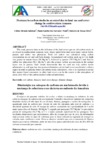Use este identificador para citar ou linkar para este item:
http://www.alice.cnptia.embrapa.br/alice/handle/doc/657801Registro completo de metadados
| Campo DC | Valor | Idioma |
|---|---|---|
| dc.contributor.author | SALIMON, C. I. | pt_BR |
| dc.contributor.author | WADT, P. G. S. | pt_BR |
| dc.contributor.author | ALVES, S. de S. | pt_BR |
| dc.date.accessioned | 2011-04-10T11:11:11Z | pt_BR |
| dc.date.available | 2011-04-10T11:11:11Z | pt_BR |
| dc.date.created | 2010-02-11 | pt_BR |
| dc.date.issued | 2009 | pt_BR |
| dc.identifier.citation | Revista Ambiente & Água, Taubaté, v. 4, n. 2, 2009. | pt_BR |
| dc.identifier.issn | 1980-993X | pt_BR |
| dc.identifier.uri | http://www.alice.cnptia.embrapa.br/alice/handle/doc/657801 | pt_BR |
| dc.description | This study presents data on the influence of the land cover type on soil carbon stocks in an Oxisol in southwestern Amazon, Acre, Brazil, under three land cover types: mature forest, pasture and rubber tree plantation. Total soil carbon was calculated using carbon concentration in soil and soil bulk density. Accumulated soil carbon stock up to 1 m depth was greater in mature forest (96 Mg ha-1), followed by pasture (79.7 Mg ha-1) and then by rubber tree plantation (56.3 Mg ha-1); also the greatest carbon accumulation in the surface layers was in pasture. Such results demonstrate that we need not only carbon stocks information by soil type, but also precise information on the land cover classification within a region in order to generate better soil carbon stocks estimations. Also, it is important to notice that mature forest conversion to other land covers can be the source to the atmosphere of about 20 to 40% of the carbon stocked in the soil previously. | pt_BR |
| dc.language.iso | eng | eng |
| dc.rights | openAccess | eng |
| dc.subject | Rubber tree | pt_BR |
| dc.subject | Árbol de goma | pt_BR |
| dc.subject | Argissolo Vermelho Amarelo | pt_BR |
| dc.subject | Red yellow argisol | pt_BR |
| dc.subject | Argisol rojo amarillo | pt_BR |
| dc.subject | Pastizales | pt_BR |
| dc.subject | Uso de la tierra | pt_BR |
| dc.subject | Carbon skins | pt_BR |
| dc.subject | Cubierta vegetal | pt_BR |
| dc.subject | Reservatorio de carbono | pt_BR |
| dc.subject | Suelos forestales | pt_BR |
| dc.title | Decrease in carbon stocks in an oxisol due to land use and cover change in southwestern Amazon. | pt_BR |
| dc.type | Artigo de periódico | pt_BR |
| dc.date.updated | 2019-01-09T11:11:11Z | pt_BR |
| dc.subject.thesagro | Cobertura do solo | pt_BR |
| dc.subject.thesagro | Carbono | pt_BR |
| dc.subject.thesagro | Estoque | pt_BR |
| dc.subject.thesagro | Cobertura vegetal | pt_BR |
| dc.subject.thesagro | Floresta | pt_BR |
| dc.subject.thesagro | Pastagem | pt_BR |
| dc.subject.thesagro | Seringueira | pt_BR |
| dc.subject.thesagro | Hevea brasiliensis | pt_BR |
| dc.subject.thesagro | Uso da terra | pt_BR |
| dc.subject.nalthesaurus | Vegetation cover | pt_BR |
| dc.subject.nalthesaurus | Forest soils | pt_BR |
| dc.subject.nalthesaurus | Pastures | pt_BR |
| dc.subject.nalthesaurus | Land use | pt_BR |
| riaa.ainfo.id | 657801 | pt_BR |
| riaa.ainfo.lastupdate | 2019-01-09 -02:00:00 | pt_BR |
| dc.contributor.institution | Cleber Ibraim Salimon, Universidade Federal do Acre (Ufac); PAULO GUILHERME SALVADOR WADT, CPAF-AC; Suhelen de Souza Alves, Universidade Federal do Acre (Ufac). | pt_BR |
| Aparece nas coleções: | Artigo em periódico indexado (CPAF-AC)  | |
Arquivos associados a este item:
| Arquivo | Descrição | Tamanho | Formato | |
|---|---|---|---|---|
| 22792.pdf | 117,28 kB | Adobe PDF |  Visualizar/Abrir |









